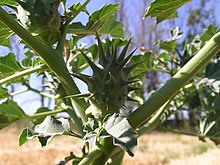Datura ferox
| Datura ferox | |
|---|---|

| |
| Scientific classification | |
| Kingdom: | Plantae |
| Clade: | Tracheophytes |
| Clade: | Angiosperms |
| Clade: | Eudicots |
| Clade: | Asterids |
| Order: | Solanales |
| Family: | Solanaceae |
| Genus: | Datura |
| Species: | D. ferox
|
| Binomial name | |
| Datura ferox | |
Datura ferox, commonly known as long spined thorn apple and fierce thornapple, as well as Angel's-trumpets,[1] is a species of Datura. Like all such species, every part of the plant contains deadly toxins that can kill animals (including humans) that ingest it. Its fruit, red-brown when ripe, has unusually long thorns or spikes.
The species was first described in 1756 by Linnaeus. Ferox means "strongly fortified," referring to the fearsome-looking spines on the seed pod. The species was long thought to have originated in southeastern China, but recent work by Symon and Haegi has demonstrated that, like all other Datura species, it is in fact native to the Americas. The species is very close in morphology to Datura quercifolia, of which it may constitute a subspecies.[2] Today it is found in all the warm parts of the earth, where it is regarded as a dangerous pasture weed.[3]
Datura ferox is a stout, upright annual herb 1.5 to 3 ft (45 to 90 cm) high. Its thick stalks often have a red-violet color at the base. All the young shoots are noticeably hairy. The most conspicuous part of the plant is its very wide, undulate, irregularly toothed leaves, which are covered with soft, downy hairs. The yellowish white flowers are funnel-shaped and inconspicuous, and usually do not open completely.[3]
Toxicity
[edit]All parts of Datura plants contain dangerous levels of tropane alkaloids and may be fatal if ingested by humans or other animals, including livestock and pets. In some places it is prohibited to buy, sell or cultivate Datura plants.[3]
References
[edit]- ^ BSBI List 2007 (xls). Botanical Society of Britain and Ireland. Archived from the original (xls) on 2015-06-26. Retrieved 2014-10-17.
- ^ 'Datura (Solanaceae) is a New World Genus' by D.E. Symon and L. Haegi in (page 197 of) Solanaceae III: Taxonomy Chemistry Evolution, Editors J.G. Hawkes, R.N. Lester, M. Nee & N. Estrada, published by The Royal Botanic Gardens Kew, Richmond, Surrey, UK for The Linnean Society of London 1991. ISBN 0-947643-31-1.
- ^ a b c Preissel, Ulrike; Preissel, Hans-Georg (2002). Brugmansia and Datura: Angel's Trumpets and Thorn Apples. Buffalo, New York: Firefly Books. p. 117. ISBN 978-1-55209-598-0.
External links
[edit]- Jepson Manual Treatment
- Additional information about Datura ferox Archived 2008-07-25 at the Wayback Machine
Text is available under the CC BY-SA 4.0 license; additional terms may apply.
Images, videos and audio are available under their respective licenses.
